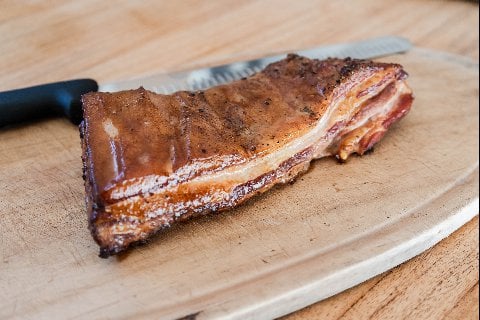Table of Contents
For decades, immersed in studying, working, learning, and teaching in the craft of meat curing, now sharing his passion with you through eat cured meat online resource.
Bacon is a cured meat that comes in many different variations, I have made bacon for 20 years and bought and enjoyed many varieties over the years.
Bacon is by far considered one of the most popular meat products due to its amazingly robust flavors and versatility of use.
But there are some variations and details I want to talk about, that don’t get mentioned much.
Most people love to have bacon added as a side to their favorite breakfast or added on top of their burger. However, in recent years, packaging for some bacon manufacturers has added a label claiming it to be “uncured” bacon.
All bacon goes through a curing process and is cured. However, some manufactured packaging labels state bacon is uncured meat. The ingredients used are what make makes label regulations define bacon as cured or uncured.
To discover why bacon is considered cured meat despite the labels, you will need to know the processes of both cured and “uncured” bacon.
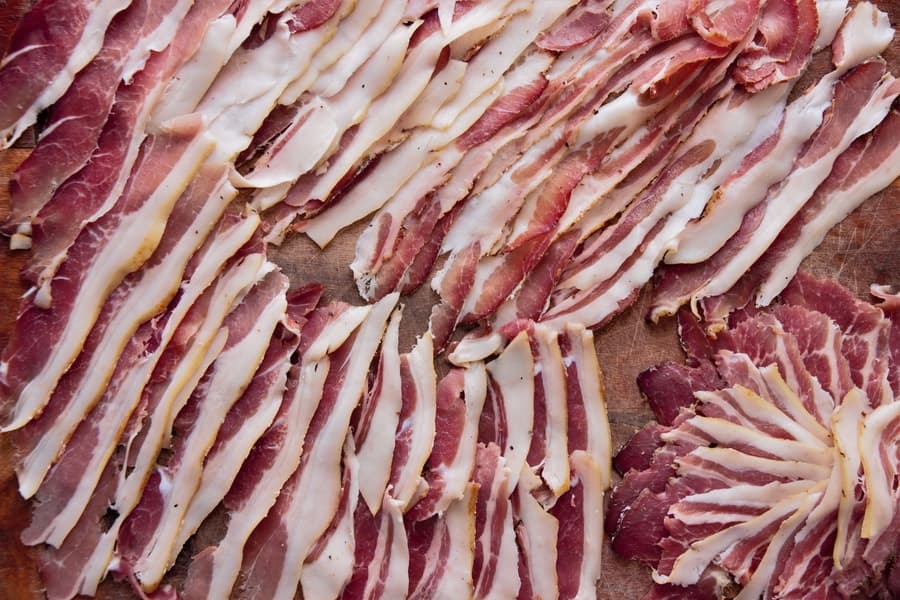
Keep reading to learn what curing is and what legislation says about the packaging confusion.
What is Cured Meat?
Meat that is commonly referred to as cured means that it has had the addition of salt in some way. The curing process typically involves covering the meat in a mixture of:
- Salt
- Seasonings
- Nitrates (Often, not always)
There are two common ways to cure meat depending on the preference of the manufacturer: dry curing, which is the more traditional method, and wet curing/brining/pickling, which involves a water/salt-based curing process.
Dry Curing
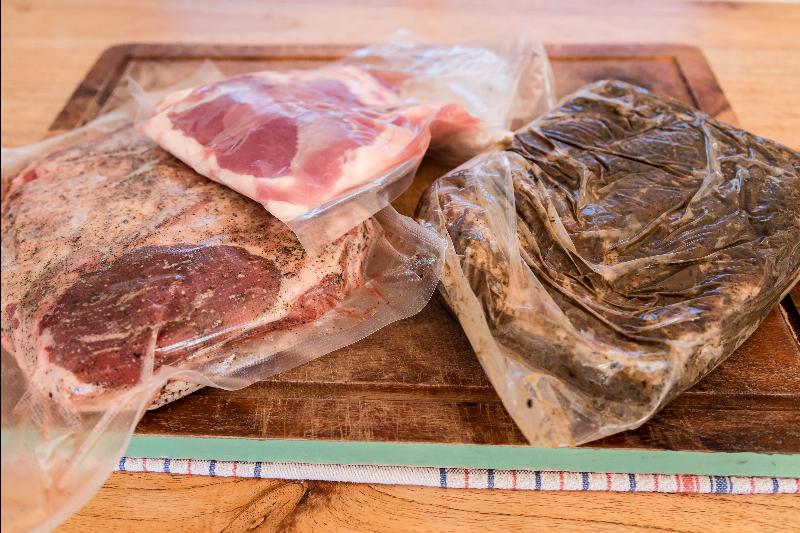
The dry-curing process involves rubbing/coating salt – using the saturation method or equilibrium curing methods onto raw pork. Then leave it in the mixture for a period of time, this is = curing.
Curing with salt gets confused with curing as using nitrates – it’s not.
After a few weeks or months depending on the technique, the meat is rinsed off and then smoked/cooked to reach an internal temperature (hot smoking), or cold smoked (also if your interested I wrote about whether cured meats are keto) and then dried.
Dry curing allows the meat to take in the seasonings in such a way as to result in a more aromatic and intense flavor than wet curing.
The process can take anywhere from a few weeks to several months for the bacon to be just right but it depends on whether it’s cooked/smoked or cold smoked/dried.
Wet Curing
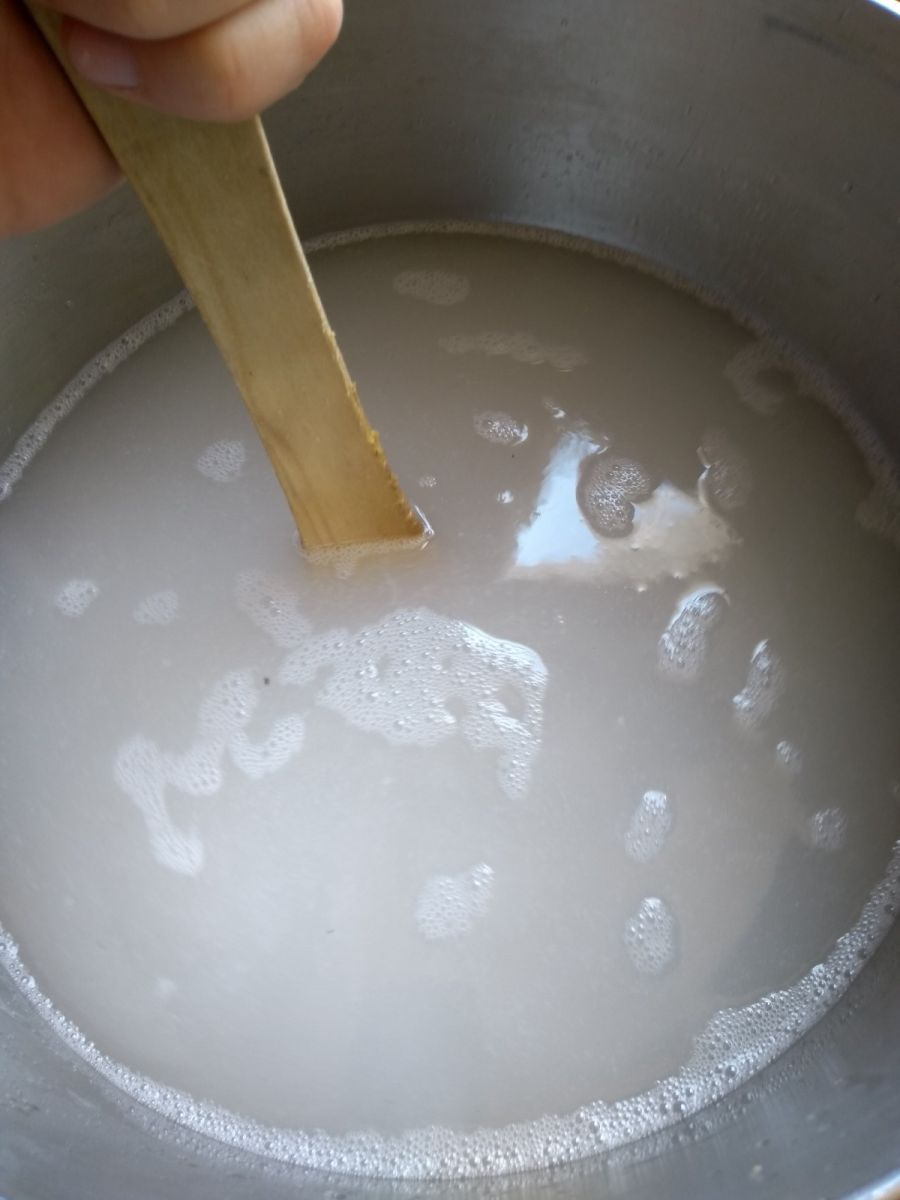
Wet curing, also known as brining, is very similar to dry curing except that the salt, seasonings, and nitrates are mixed with water.
Additionally, the meat is not only soaked in the brine but can also be injected so that the cure is more evening distributed. For many commercial kinds of bacon, a needle-injected conveyor belt is used to quickly force in the wet brine/cure.
Since most manufacturers prefer to speed up the process, they use other methods to smoke the bacon, such as adding liquid smoke.
This allows the process to take only a few days to get a more commercial product, which leads to different outcomes. Often this type of commercial bacon has other additives to give it a pinkish color, shelf life etc.
The most significant commonality between the two processes is that they use salt to cure, and they both are smoked for some time afterward. Either smoked/cooked, cold smoked/dried, or commercial liquid smoke added to skip smoking and bring to market quicker.
The difference is that with wet curing, I’ve found that spices can be more subtle than dry curing.
Different Cured Types of Bacon Cuts
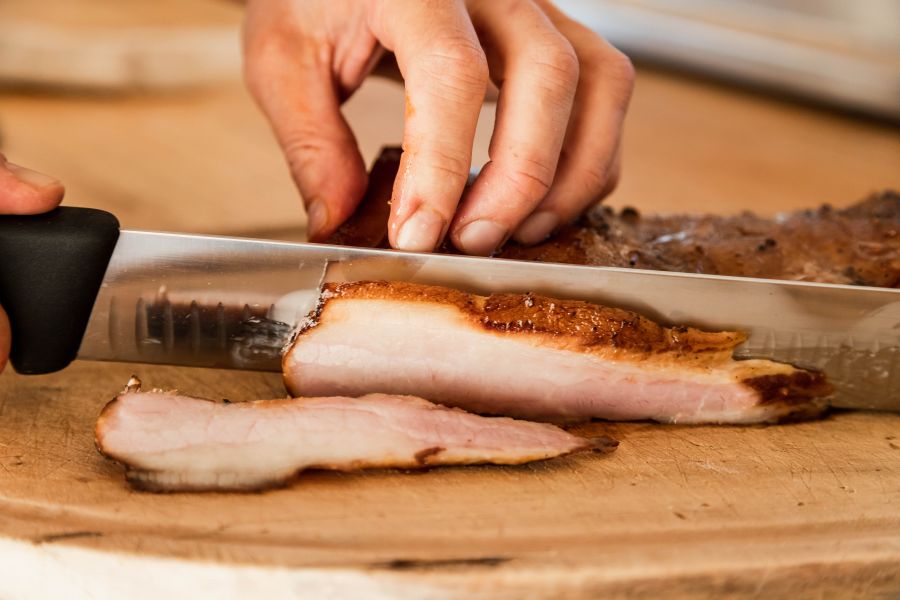
Bacon has been a staple at the breakfast table for many people over the years.
But did you know that there is a difference between where the meat comes from on the pig? The most considerable distinction between the types is the texture.
In the United States, the meat where you get the bacon you commonly eat is from the side of the pig. This is referred to as pork belly.
In Canada, however, they make the cut from the loin to make bacon (you can use many other cuts for bacon, I wrote about it here). This results in a different, less fatty texture that is more like ham sometimes. This is what is referred to as Canadian bacon.
While bacon comes from different areas on the pig, there are also different varieties of bacon that you can purchase.
Many people are used to picking up their bacon in the supermarket aisle, but you can get it at the butcher’s counter as well (sometimes more passion and care is applied too).
These types of bacon vary in either the part of the pig they come from or the different curing methods and seasonings used.
Nonetheless, they are all considered cured bacon.
So some below are hot smoked/cooked and others are cold smoked/dried.
Here are some bacon varieties:
Slab Bacon
This is bacon that is picked up at the butcher’s counter. It is referred to as slab because it is not precut bacon. The butcher typically cuts it to your specifications of thickness and how much you desire. Additionally, the rind, or covering, is still on the slab and can be removed.
The slab is often a chunk of the pork belly’s whole muscle.
You can also purchase the slab and do the cutting yourself.
Center-Cut Bacon
This is usually a cut of the meat that comes from the pork belly and is trimmed of some fat or maybe a cut closer to the bone. This provides a less fatty option for those who are more health-conscious.
Side Bacon
Bacon from above the pork belly, sometimes this is a thicker cut depending on the age of the animal.
Canadian Bacon
This cut of bacon comes from the middle of the back of the pig, along either side of the spine.
It is typically a much leaner option and is cut in round slices.
The texture comes closer to resembling ham than it does bacon since it is often hot smoked/cooked.
Buckboard Bacon
This bacon comes from the upper pork shoulder and is often referred to as pork butt.
This style of bacon goes through the same curing and smoking process as regular bacon; however, it tends to be a thicker, meatier cut.
“Uncured” Bacon
Uncured bacon has natural instead of synthetic nitrates added, it’s due to USA packaging/food regulations, but it’s still cured with salt.
This cut is one of the more controversial cuts of bacon. This is because the meat is often the same cut as regular bacon and goes through the same process as “cured” bacon.
This, in my opinion, was a mistake by the health authorities, since they have then defined ‘uncured’ as the use of natural nitrates. Whilst it is Salt Cured.
Pancetta (Not Bacon but a Similar Dry Cured Process for Artisan dry curing)
This classic Italian salumi is similar to that of regular bacon since it is salt-cured and dry-cured.
It’s cured and dried to be either consumed once the appropriate weight loss has occurred or can be used in cooking.
The main herbs used are often: Juniper berries, Thyme, Bay Leaf/Sweet Laurel, and Pepper
The biggest difference is that it is cured like other dry-cured bacon, but it does not go through the smoking process.
It’s also cut wafer-thin to be savored!
Details Between Cured and Uncured Bacon?
When it comes to preparing bacon for consumption, it is crucial to understand that it all has to go through some type of process to make it safe and free of harmful bacteria. While the processes are the same, the ingredients used for each can be different.
Keep in mind that when curing meat, an individual will use ingredients such as seasonings, salt, and sometimes nitrates to complete the process.
Whether dry or wet curing, the same ingredients are used, and more specifically, the nitrates are for the incredibly low chance of botulism and color.
For bacon that is considered uncured, instead of the synthetic nitrates that are added in, the process uses various vegetable powders such as celery and beetroot. These vegetables have a naturally-occurring nitrate that is then added to sea salt to create a chemically-free product.
You can see, that the biggest difference between cured and uncured is the natural form of the nitrate that is added in.
Does this really mean that the bacon you consume is uncured and free of nitrates? No, it does not. However, the difference is that one is using natural nitrates. Most of the nitrates you consume can come from dark green vegetables and you also have nitrates naturally occurring inside your body.
I’ve seen research where at temperatures over 350F/180C – nitrates can convert to nitrosamines which may be negative for your health.
Here is a link to a page I did with more research for you to read.
What Are Nitrates and Why Are They Bad For You?
Nitrates are a set of compounds that involve nitrogen and oxygen molecules. While they are often associated with cured meats, green, leafy vegetables are actually much richer in nitrates.
Foods High in Nitrates – webmd.com
Nitrates are a chemical compound that has been used for many years as a way to preserve various types of food.
The level of nitrates and nitrites provided by natural sources can be less than or greater than synthetic nitrates and nitrites, as this varies greatly between products. However, that means these organic and natural meat products still retain the potential to produce nitrosamines when cooked at high heats because they still contain nitrites. The source of the nitrites does not matter when undergoing a chemical reaction.
https://www.canr.msu.edu/news/preservatives-exploring-nitrate-nitrite-safety
Seems regardless of natural or synthetic this chemical reaction still happens.
Our bodies produce nitrates, from the above academic write-up.
If you want bacon with nitrates in it, try making your own.
Natural nitrates are found in many vegetables such as celery and are also used to cure meat. However, research shows that nitrates can be offset with some vegetables by adding or having naturally occurring Vitamin C in them.
However, in recent studies, researchers have found that whether the nitrate is synthetic or naturally occurring, it is still a nitrate. This means that even though it is found in the vegetables that are part of a healthy diet, they still contain the same compound that can cause cancer.
What is the Legislation Around Cured and Uncured Labels?
Since the beginning of the “uncured” products showing up on the market, it was mandated by the USDA’s Food Safety and Inspection Service, or FSIS, that they have a label that states, “Uncured,” and “No Nitrate or Nitrate Added.”
This mandate came from the USDA’s insistence that the public is aware of the differences in the products and for full disclosure purposes.
In America:
Because of this, you can see that in your local supermarket, the processed meat section has been expanded tremendously by manufacturers who have adopted the label.
In recent years, however, it has become clear that some organizations have opposed this distinction, even stating that it was misleading and confusing to consumers. This is especially true since the process for both cured and uncured is the same, minus the synthetically used nitrates.
Such organizations as the Center for Science in the Public Interest, or CSPI, have petitioned the USDA to ban labels claiming meats to be “uncured” and “nitrate-free.” Neither process used is completely nitrate-free, and labeling it as such is dishonest to consumers.
Since the petition was started, the FSIS has issued a statement saying that they are recommending to the USDA that those such terms be banned from packaging labels. In addition, they suggest that new definitions for what qualifies as “cured” and “uncured” be revamped, so a better solution is made clear to the public consumer.
The biggest reason for this suggested clarification is that in recent studies, it was proven that even naturally occurring nitrates might contain traces of the nitrate component that can be converted into cancer-causing agents.
Because of the processes used, there really is no difference between cured meat and what is referred to as “uncured.” This is because both go through a process that is designed to protect and preserve the meat to prevent bacteria from entering it.
Uncured Packaging Confusion
Putting the differences in the legislation aside, you still have the consumer confusion of the packaging labels.
Consumers of bacon everywhere are purchasing their product that is labeled “uncured” and “no nitrates or nitrates added” when this is not true.
Many people wonder why the USDA would require such a label when the product does have nitrates added to it.
The reason is that the ingredient used to add this nitrate is celery and beets, which are vegetables and are deemed healthy – false I think.
At the time that the USDA began requiring the label for the “uncured” variety, curing agents were known as those that are synthetically produced. This did not include the nitrates that are found naturally in celery or beets.
A loophole that is commercially exploited.
This means that consumers everywhere, or at least those who are more health-conscious, are purchasing meat labeled “uncured” thinking they are making a healthy choice. Many experts agree that this is not the case.
Make your own, and enjoy the craft.
Final Thoughts
Is all bacon cured = yes
Is uncured bacon cured = yes
Get educated and do your own research then make an informed decision, at the end of the day – you are putting your choice of food in you!
I do not use any nitrates/nitrites in my whole muscle meat curing projects. Since often, I will be cooking it at higher heat and also just prefer to have control over what goes into it.
Whether it has been dry or wet cured in synthetic or natural ingredients, it is cured.
Labeling can get confusing, especially when you consider that nitrate may just be celery and isn’t synthetic.
Sources:
https://www.huffpost.com/entry/guide-bacon-labels_n_6609150

